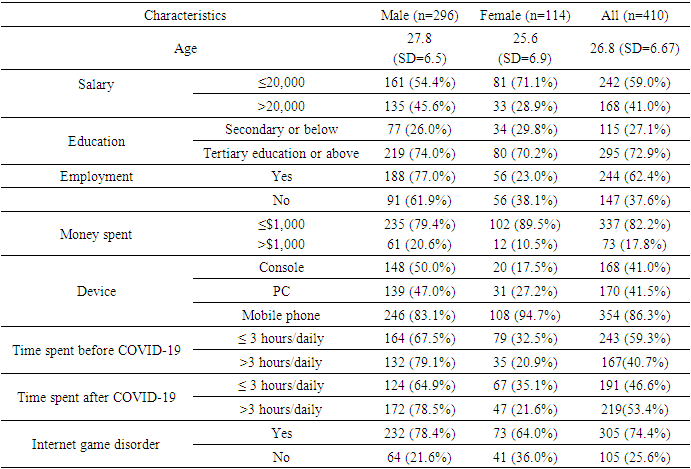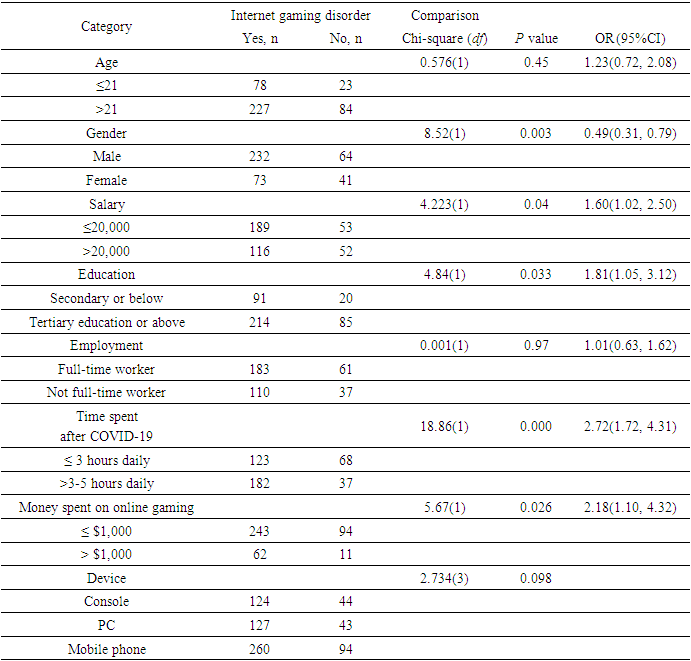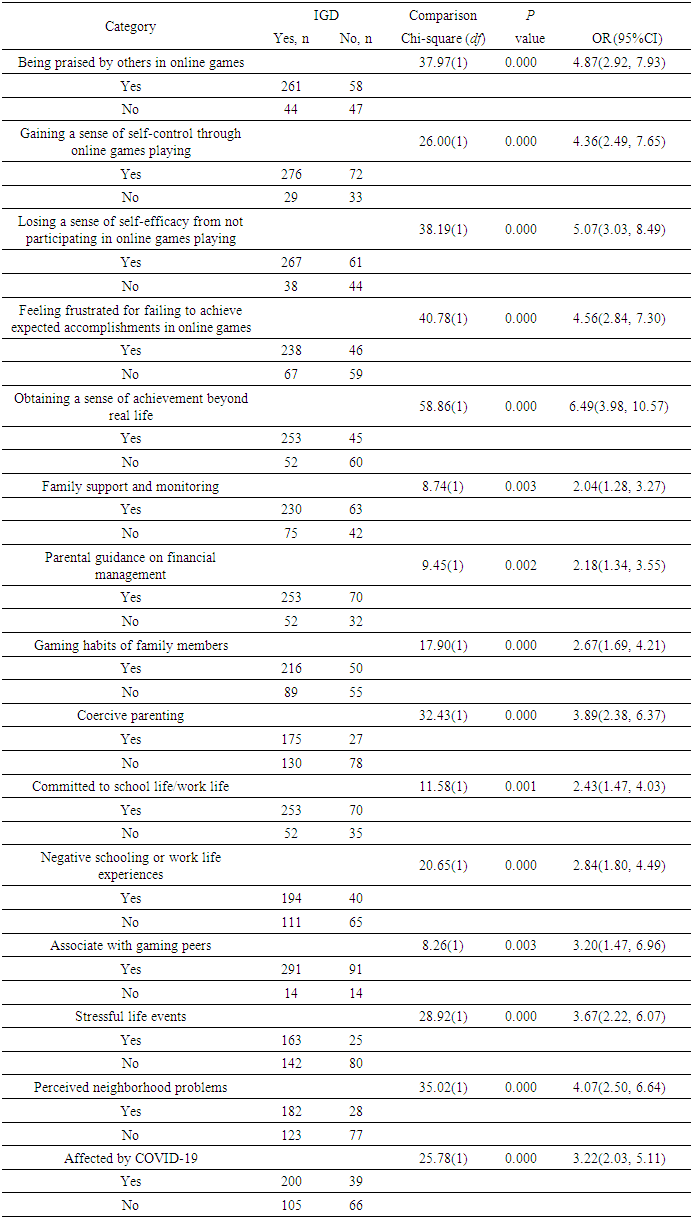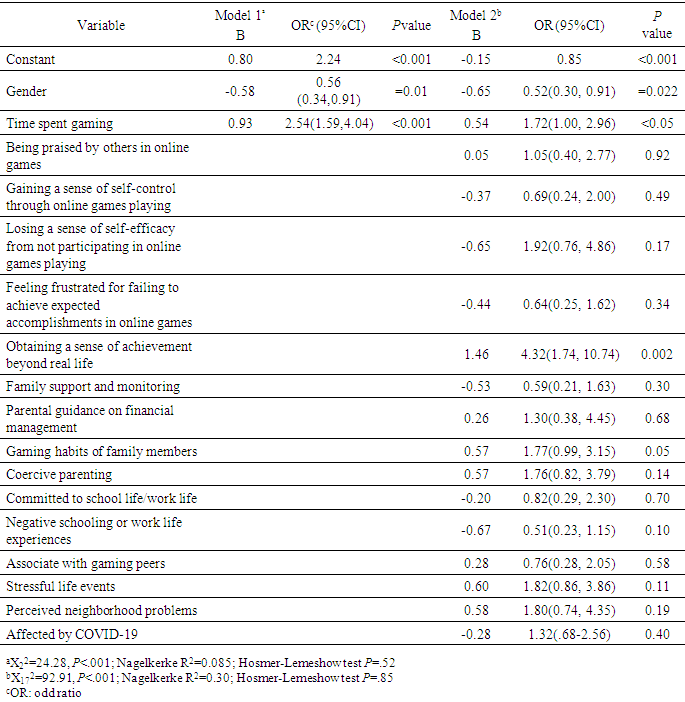-
Paper Information
- Paper Submission
-
Journal Information
- About This Journal
- Editorial Board
- Current Issue
- Archive
- Author Guidelines
- Contact Us
International Journal of Psychology and Behavioral Sciences
p-ISSN: 2163-1948 e-ISSN: 2163-1956
2021; 11(2): 31-39
doi:10.5923/j.ijpbs.20211102.02
Received: Aug. 17, 2021; Accepted: Sep. 10, 2021; Published: Sep. 26, 2021

The Impact of COVID-19 and Socio-Psychological Determinants on Chinese Internet Game Players: A Cross-Sectional Study
Yida Y. H. Chung
Felizberta Lo Padilla Tong School of Social Sciences, Caritas Institute of Higher Education, HKSAR
Correspondence to: Yida Y. H. Chung, Felizberta Lo Padilla Tong School of Social Sciences, Caritas Institute of Higher Education, HKSAR.
| Email: |  |
Copyright © 2021 The Author(s). Published by Scientific & Academic Publishing.
This work is licensed under the Creative Commons Attribution International License (CC BY).
http://creativecommons.org/licenses/by/4.0/

Since the outbreak of the COVID-19 pandemic, the total number of hours and total amount of money spent by Chinese game players on pay-to-play online games has increased dramatically. The current study's goal is to investigate the demographic characteristics, internet game playing patterns, and socio-psychological situations of 410 young people aged 15 to 40 in Hong Kong. From March to June 2020, a cross-sectional study was conducted using purposive sampling on pay-to-play internet game players. A 9-item Internet Gaming Scale (IGD) and a Socio-psychological Determinants Checklist-15 are among the measurement instruments used. To investigate the correlations between demographic data, socio-psychological variables, and internet gaming disorder displacement, chi-square, crosstab, and logistic regression analyses were used. The prevalence rate of internet gaming disorder was 74.4% (n=305) among the 410 respondents, with a mean age of 26.8 years old (SD=6.7). Approximately 29% of respondents spent more than 5 hours per day and 20% spent more than HKD1,000 per month on internet games. Meanwhile, 86.3% of respondents played internet games on their mobile phones. According to bivariate analysis, internet gaming disorder was associated with gender, gaming hours, education, salary, money spent on internet games, and socio-psychosocial factors. In a logistic regression model, internet gaming disorder was correlated with daily gaming hours. The findings suggested the prevalence of internet gaming disorder among internet game players in Hong Kong. In view of the high percentage in internet gaming disorder, should we reconsider the inclusion and exclusion of criteria for IGD. In addition, preventive measures should be developed to help individuals with the socio-psychological determinants. Internet gaming disorder was found to be related to daily gaming hours in a logistic regression model. The findings indicated a high prevalence of internet gaming disorder among Hong Kong internet game players. Given the high prevalence of internet gaming disorder, should we reconsider the inclusion and exclusion of IGD criteria? Furthermore, preventive measures to assist individuals with the socio-psychological determinants should be developed.
Keywords: Internet gaming disorder, Socio-psychological determinants, Chinese internet game players
Cite this paper: Yida Y. H. Chung, The Impact of COVID-19 and Socio-Psychological Determinants on Chinese Internet Game Players: A Cross-Sectional Study, International Journal of Psychology and Behavioral Sciences, Vol. 11 No. 2, 2021, pp. 31-39. doi: 10.5923/j.ijpbs.20211102.02.
Article Outline
1. Introduction
- The invention and proliferation of information technology have accelerated web-based device application and internet service utilization. The growing trend of electronic data interchange applications through computers and hand phones has provided business opportunity for internet game companies to make profits through such devices. According to the Video Game Market Size, Share and Trends Analysis Report by Device, By Type, By Region, and Segment Forecasts, 2020-2027, the video game market worth USD167.5 billion in 2020, and it is expected to reach USD291.16 billion in 2027. In the 2020 revenue of the US, it was found that there was an increase of 14.6% in mobile digital games sold, 11.8% increase in pay-to-play PC sold, and 27.9% increase in console sold as compared with the revenue of 2019 (Nielsen Company, 2021). Parallel to the growth of video game profit, the development of purchasing in-game content is ever expanding. The common concern on whether the lockdown measure during the COVID-19 pandemic may lead to a significant impact on risk of internet gaming addiction has become a hot topic for discussion, particularly when there were many reported staying homes cases for playing online games to kill time (Ko, & Yen, 2020; King et., 2020).Video games may be classified as leisure entertainment, relaxation games, or competitiveness. On a well-balanced approach, the amount of time and money that the player spends on this bobby should not exceed a reasonable percentage for a normal everyday life. Those who cannot achieve such goals may be suffering from an online addiction or a gaming disorder. Internet gaming disorder is considered a behavior addiction. According to the Section III of the 5th edition of the Diagnostic and Statistical Manual of Mental Disorders (DSM-5), as a “persistent and recurrent use of the Internet to engage in games, often with other players, leading to clinically significant impairment or distress” and is regarded as a tentative psychiatric disorder (American Psychiatric Association, 2013, p.795). Gaming disorder is defined in the 11th Revision of the International Classification of Diseases (ICD-11) as a pattern of gaming behavior characterized by impaired control over gaming, increasing priority given to gaming over other activities to the extent that gaming takes precedence over other interests and daily activities, and continuation or escalation of gaming despite the occurrence of negative consequences. For gaming disorder to be diagnosed, the behaviour pattern must be of sufficient severity to result in significant impairment in personal, family, social, educational, occupational, or other important areas of functioning and would normally have been evident for at least 12 months.Research findings suggested that the prevalence rates of internet gaming disorder (IGD) being reported from 0.6% to 5.4% around the world (Rehbein, et al., 2015). Among adolescents, it ranged from 0.6% to 19.9% in the global context (Brilliant, et al., 2019). For the Chinese adolescents, the prevalence rate for Chinese mainland adolescents was 17.0% (Liao et al., 2020), for Hong Kong adolescents was ranged from 5.3% to 15.7% (Wang et al., 2014; Zhu et al., 2021). Zhu et al. (2021) further indicated that there was 20.9% of the respondents demonstrated excessive pathological game behavior which was an alarming phenomenon. Notably, Wang et al. and Zhu et al. focused on the prevalence, family characteristics, and correlation between loneliness and internet game addiction. Yu and Fu (2019) conducted another local study to investigate the relationships between internet gaming addiction, internet gambling addiction, and illusory control. The target population of these studies was upper primary or secondary school students. Wang et al. and Zhu et al. used the Game Addiction Scale (GAS) to assess internet game addiction, whereas Yu and Fu used Internet Gaming Disorder Scale. Recently, there has been no agreement on which screening instrument should be used to diagnose internet gaming disorder. It has been observed that more online game players prefer to purchase game content (Hamari et al., 2017). However, no local studies have been conducted to adult game players to investigate their pay-to-play online game pattern or the impact of socio-psychological determinants on internet gaming disorder. The primary goal of this study which was originally set to investigate the relationships between internet gaming disorder and socio-psychological determinants among Chinese online game players aged range between 15 and 40 years old and the results obtained suggested preventive measures.
2. Methods
2.1. Participants
- All subjects were selected by purposive sampling. The inclusion criteria were Hong Kong online game players aged 15 to 40, being able to read Chinese characters, have engaged in pay-to-play online games.
2.2. Procedure
- A cross-sectional study was conducted from March to June 2020. Participants were recruited through video game page, general video game chat groups. The host of the page and chat groups were invited to promote the survey by inviting their members who met our recruitment criteria to fill out the questionnaire through scanning the QR codes. We also had interviewers recruited appropriate participants outside video game plaza and fill out the questionnaires with recruitment team’s iPad. All participants had to give their consent before administering the questionnaire. Information regarding sociodemographic data (i.e., gender, age, occupation) and game-related data (i.e., daily time spent on playing online games, monthly expenditure spent in purchasing game content, favorite types of online game genre) was collected. Questionnaire data was collected through smartphone technology-based tools, i.e., Google Forms. It comprised of collecting and recording participants’ information at the same time. Despite its economically and environmentally friendly, this data collection method could avoid skip-pattern related errors as it checked and validated the smartphone-administered questionnaires automatically. Each respondent took approximately 20 minutes to complete the survey. Ethical approval was obtained from the Human Research and Ethics Committee of the author’s institute (Reference No. HRE200101).
2.3. Measurements
2.3.1. Social and Demographic Information
- Demographic and personal information obtained included gender, age, nationality, occupation, income, education.
2.3.2. Game Playing Pattern
- Respondents were asked to report their gaming pattern, included time spent on playing online game daily before and after COVID-19 pandemic, game device used for playing games, game genres, and amount of money spent in purchasing game content.
2.3.3. Game Addiction
- The Chinese 9-Item Internet Gaming Disorder Scale- Short Form (Chen et al., 2019).The Internet Gaming Disorder Scale – Short Form is a nine-item scale screening tool for having internet gaming disorder according to DSM-5. The cut- off for internet gaming disorder is 5 out of 9 criteria. We employed it to assess severity of IGD based on IGD questions in DSM-5. A 6-point Likert scale was used for response options (1=never, 2=rarely, 3=sometimes, 4=often, 5=very frequently, 6=always). In this paper, the “never” response was recoded as “0”, the “rarely”, “sometimes”, “often”, “very frequently” and “always” responses were combined to form the score “1” to mirror the dichotomous nature of DSM-5 criteria. The Chinese 9-item Internet Gaming Disorder Scale- Short Form has been validated with excellent internal consistency (Chen et al., 2019). The internal consistency of this scale is Cronbach’s α=.92.
2.3.4. Socio-Psychological Determinants
- Socio-psychological Determinants Checklist (SPCL-15) was used to assess the socio-psychological factors affecting gaming behavior through 15 items related to family bonding, peer influence, social strain, and psychological factors. Respondents were invited to think about the sentences that could best represent their situations and to rate the similarity on a 6-point Likert scale (1= completely different, 2= largely different, 3= somewhat different, 4= similar to my situation, 5= somewhat the same, 6= completely the same). In this paper, the “completely different” response was recoded as “0”, the “largely different”, “somewhat different”, “similar to my situation”, “somewhat the same” and “completely the same” responses were combined to form the score “1”. The internal consistency of this scale is Cronbach’s α=.88.
3. Statistical Analysis
- The data were analyzed using statistical software (Statistical Package for Social Sciences for Windows version 21, IBM Corp). The characteristics of respondents are reported descriptively. The relationships of characteristics, socio-psychological determinants, internet gaming disorder were determined using Chi-square and Fisher exact tests. In addition, the stepwise binomial logistic regression analysis was applied to examine the multivariate relationships among the internet gaming disorder, respondents’ characteristics, and socio-psychological determinants. Furthermore, McNemar-Bowker test was used to compare time spent in playing online games before and after COVID-19.
4. Results
- Respondent CharacteristicsThe study comprised 410 respondents, of which 72.2% were male (n=296) and 27.8% were female (n=114). The age range of the respondents was between 15 and 40 with an average of 26.8 years old (SD=6.7). All of them resided in Hong Kong, with majority of them were Chinese (94.4%), the remaining were from Japan, Macau, Ireland, Austria, Singapore, and Taiwan. 32.0% of the respondents were students (n=131), 1.2% were housewife, 2.7% were unemployed. The remaining 64.1% were full-time workers with 9% were manager and administrator, 22% were professional, 6.8% were clerical worker, 8.8% were service worker and sales, 16.5% were skilled worker, and 1% was non-skilled worker. Among those respondents, 77.0% reported that they had attained tertiary or above education, while the remaining got secondary school or lower education level at the time of the study. Both genders preferred smartphone for playing online games (354/410, 86.3%). About 82% of the respondents spent less than HK$1,000 in purchasing online game content, while 18% spent more than HK$1,000 (Table 1).
|
|
|
|
5. Discussion
- Prevalence of Internet Gaming Disorder among Hong Kong online game playersIn this study, there is a high percentage of the respondents (74.4%, 305/410) that has met the criteria for internet gaming. Notably, the findings suggested that COVID-19 pandemic had significant impact on respondents’ online gaming duration which was highly associated with internet gaming disorder. Such findings echoed with prior studies (Fernandes et al., 2020; King et al., 2020; Xu et al., 2021; Zhu et al., 2021) on the impact of internet gaming on adolescents and young people during COVID-19. In this study, a comparatively high percentage (74.4 percent) of respondents demonstrated internet gaming disorder, as evidenced by the amount of money spent on online games. Purposive sampling with pay-to-play online game players could be related to this. People who spent more money on pay-to-play online games were more likely to become addicted to online games, according to Biegun et al. (2020). According to the findings (Hamari et al., 2017; Wohn, 2014), these players paid for in-game content for a variety of reasons (i.e., level up, getting gifts, playing with friends). Consequently, they might develop the habit of chasing and become addicted to online games. The growing trend of web and the advancement of 5G wireless technology in Hong Kong may contribute to the increased number of IGD. Smartphone utilization (99.7%) was the most popular mode of device used to connect to internet in Hong Kong (The Thematic Household Survey Report No. 69, Census and Statistics Department, HKSAR, 2020). Apart from availability of smartphones, low WIFI fee and readily accessible game apps nowadays cause changes to people’s leisure and social life pattern. Games propagated through the smartphones are gradually replacing games formerly supplied from amusement sources or other less popular media.Gender difference in Internet Gaming DisorderAn association of gender and internet gaming disorder was found in this study though the male respondents were 0.49 times slightly more than females. The result was consistent with previous findings (Siste et al., 2021; Teng, et al., 2020; Zhu et al., 2021). In the past, people tended to accept that females were weaker than males in the fields of information technology application and control panel operations. Yet the phenomenon has changed upon the invention of smartphones in the 21st century with a user-friendly approach. Operating of smartphones is basically easy and simple for modern people of either sex nowadays. Socio-psychological Determinants Checklist and Internet Gaming DisorderBivariate analysis revealed the significant correlations of all four domains in socio-psychological determinants checklist and internet gaming disorder. In the psychological domain, respondents’ being praised, gaining a sense of self-control and self-efficacy, being frustrated for failing to achieve expected accomplishment in online games, and obtaining a sense of achievement beyond real life resulting a higher chance of 4-6 times more likely to suffer from internet gaming disorder. In our everyday life, psychological aspiration is the basic need for self-motivation. People would rather choose joining activities that they find meaningful and beneficial to them but avoid from joining those with adverse experiences. However, if a person cannot gain positive self-concepts or self-efficacy, he or she may try to obtain such sort of reinforcement from the virtual world. Such findings echoed previous research findings (Fernandes et al., 2020; Xu et al., 2021). Regarding the family and peer domain, the findings in this study showed that respondents with family members and peers have gaming habits and coercive parenting were about 3 times more likely to demonstrate IGD. Homeowners and peers are very important to individuals. When family members and friends are gaming enthusiasts, it will encourage / promote them to participate in gaming activities. Over-control from family members may provoke respondents to become even more rebellious and addicted to the internet games. Conversely, a positive and friendly environment fostered in the family will help the family members in joining healthy activities together during the pandemic. A battery of studies suggested that players used gaming to evade from their real life. Internet gaming was an avoidant coping behavior for these players in dealing with their negative emotion (Goh et al., 2019; Kahn et al., 2015; King et al., 2020). Our study had identified the correlations between social strain and internet gaming disorder among online game players. These social strains included negative school or work life experiences, stressful life events such as parental divorce, death of family members, perceived neighborhood problems, and events brought along by COVID-19. The relationship of social strain and emotional distress are suggested to be addressed in future research studies. Strength and LimitationsAccording to a review of the literature, this was the first study aimed at online game players in the Hong Kong context. The sample population included both adolescent and adult internet game players. The findings will aid us in understanding the impact of socio-psychological determinants on internet gaming in a broader context. Several limitations have been identified in previous studies. First, one significant limitation stemmed from the sample issue, with its population parameter of internet gaming unknown. It was impossible to estimate the sample size accurately using random sampling with internet game players, so purposive sampling with a chain-referral was inevitably used in this study. Because of these constraints, the findings may not be directly applicable to other internet game players in other contexts. Furthermore, we used a cross-sectional design to investigate the characteristics of internet game players and their relationship with internet game disorder. Data obtained within a specific time frame always resulted in a restriction on the direction of causality. While under the influence of COVID-19, there may be variations in internet game playing-related factors that need to be explored and addressed further.
6. Conclusions
- This study examined the characteristics and socio-psychological determinants of internet game players and its relationship with internet gaming disorder. While the daily gaming hours were used as the predictor of internet gaming disorder, to strike the balance, family members’ involvement in online games and the sense of achievement that players obtained in the virtual world were also be significantly considered as predictors as well. The findings improved our understanding of online game players’ gaming patterns; however, it is suggested that a broader range of factors be investigated by widening the sample population in different classes and age groups. Furthermore, health practitioners should be on the high alert for the high number of online gamers who may be suffering from a gaming disorder as a result of the pandemic. Future research is needed to investigate into the mental health conditions of online gamers.
ACKNOWLEDGEMENTS
- This study was supported by funding from Junior Chamber International (North District) and Sunshine Lutheran Centre-Hong Lutheran Social Service.
 Abstract
Abstract Reference
Reference Full-Text PDF
Full-Text PDF Full-text HTML
Full-text HTML


